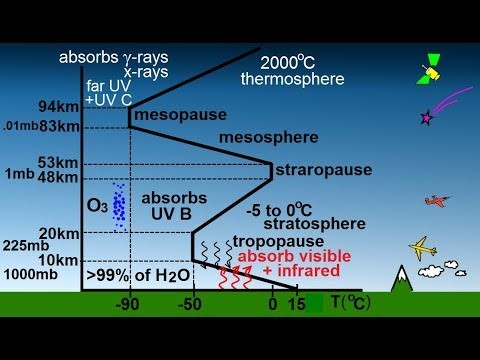The General Science and Ability Past Paper Question has been attempted by Hina Zulfiqar, a CSS English and Compulsory Course student. Along with other aspirants, she learns how to prepare and attempt GSA questions to score up to 90 marks under the guidance of Miss Iqra Ali and Dr. Nishat Baloch, Pakistan’s top CSS GSA coaches providing coaching at Howfiv.
CSA Solved Past Paper 2020 | Briefly Describe the Various Segments of Atmosphere and How these Segments are Maintaining the Earth Radiation Balance?
Atmosphere:
The envelope of gases surrounding the earth or another planet, It is a mixture of gases that is held by gravity, is called the atmosphere.

Gases in atmosphere
Without our atmosphere, there would be no life on earth. Two gases make up the bulk of the earth’s atmosphere: nitrogen (78%), and oxygen (21%). Argon, carbon dioxide and various trace gases make up the remainder like 0.93% argon, 0.04% carbon dioxide, and small amounts of other gases. Air also contains a variable amount of water vapour, on average around 1% at sea level and 0.4% over the entire atmosphere.
Layers of Atmosphere
The atmosphere of earth, broadly speaking, consists of five major layers unlisted as:
- Troposphere
- Stratosphere
- Mesosphere
- Thermosphere
- Exosphere

1. Troposphere
The troposphere is the first layer above the surface and contains half of the Earth’s atmosphere. Weather occurs in this layer. Known as the lower atmosphere, almost all weather occurs in this region. The troposphere begins at the Earth’s surface and extends from 4 to 12 miles (6 to 20 km) high. The height of the troposphere varies from the equator to the poles. It is around 11-12 miles (18-20 km) high at the equator, at 50°Nand 50°S, 51⁄2 miles and the poles just under four miles high. As the density of the gases in this layer decrease with height, the air becomes thinner. Therefore, the temperature in the troposphere also decreases with height in response. As one climbs higher, the temperature drops from an average around (17°C) to (-50°C) at the
Tropopause: It is the region that has mixing characteristics of both Stratosphere and mesosphere, it exists where one layer end and the other starts.
2. Stratosphere
Many jet aircraft fly in the stratosphere because it is very stable. Also, the ozone layer absorbs harmful rays from the Sun. The Stratosphere extends around 31 miles (50 km) down to anywhere from 4 to 12 miles (6 to 20 km) above the Earth’s surface. This layer holds 19 percent of the atmosphere’s gases but very little water vapour in this region; the temperature increases with height. Heat is produced in the process of the formation of Ozone and this heat is responsible for temperature increases from an average (-50°C) at Tropopause to a maximum of about (-15°C) at the top of the stratosphere. This increase in temperature with height means warmer air is located above more relaxed air. This prevents “convection” as there is no upward vertical movement of the gases. The ‘anvil-shaped tops readily see the location of the bottom of this layer of cumulonimbus clouds.
Stratopause: The transition boundary which separates the mesosphere from the stratosphere is called the stratopause.
3. Mesosphere
Meteors or rock fragments burn up in the mesosphere. This layer extends from around 31 miles (50 km) above the Earth’s surface to 53 miles (85 km). The gases, including the oxygen molecules, continue to become denser as one descends. As such, temperatures increase as one descends, rising to about 5°F (-15°C) near the bottom of this layer. The gases in the mesosphere are now thick enough to slow down meteors hurtling into the atmosphere, where they burn up, leaving fiery trails in the night sky. Both the stratosphere (next layer down) and the mesosphere are considered the middle atmosphere.
Mesopause: The transition boundary which separates the thermosphere from the mesosphere is called the stratopause.
4. Thermosphere
The thermosphere is a layer with auroras. It is also where the space shuttle orbits. Between about (80 km) and (500-1000 km) lies the thermosphere. This layer is known as the upper atmosphere. While still extremely thin, the gases of the thermosphere become increasingly denser as one descends toward the earth. As such, incoming high energy ultraviolet and x-ray radiation from the sun begins to be absorbed by the molecules in this layer and causes a large temperature increase. Because of this absorption, the temperature increases with height. From as low as (-120°C) at the bottom of this layer, temperatures can reach as high as (2,000°C) near the top. However, despite the high temperature, this layer of the atmosphere would still feel very cold to our skin due to the very thin atmosphere. The high temperature indicates the amount of energy absorbed by the molecules but with so few in this layer, the total number of molecules is not enough to heat our skin.
Northern Lights
The bright dancing lights of the aurora are collisions between electrically charged particles from the sun that enter the earth’s atmosphere. The lights are seen above the magnetic poles of the northern and southern hemispheres. Thus, they are known as ‘Aurora Borealis’ in the north and ‘Aurora australis in the south.. The lights of the Aurora generally extend from 80 kilometres (50 miles) to as high as 640 kilometres (400 miles) above the earth’s surface.
Thermopause: The transition boundary which separates the exosphere from the thermosphere
is called stratopause.
5. Exosphere (Upper atmosphere)
The atmosphere merges into space in the extremely thin exosphere. This is the upper limit of our atmosphere. This is the outermost layer of the atmosphere. It extends from the top of the thermosphere to (10,000 km) above the earth. In this layer, atoms and molecules escape into space and satellites orbit the earth. At the bottom of the exosphere is the thermopause located around (600 km) above the earth.
The Edge of Outer Space
While there’s really no clear boundary between where Earth’s atmosphere ends and outer space begins, most scientists use a delineation known as the Karman line, located 100 kilometres (62 miles) above Earth’s surface, to denote the transition point, since 99.99997 per cent of Earth’s atmosphere lies beneath this point. A February 2019 study using data from the NASA/European Space Agency Solar and Heliospheric Observatory (SOHO) spacecraft suggests, however, that the farthest reaches of Earth’s atmosphere — a cloud of hydrogen atoms called the geocorona — may actually extend nearly 391,000 miles (629,300 kilometres) into space, far beyond the orbit of the Moon.

How are these layers maintaining the Earth’s radiation balance?
The Earth-Radiation balance is the balance between incoming energy from the sun and outgoing from the Earth. The energy released from the Sun is emitted as shortwave light and ultraviolet radiation. When it reaches the Earth, some are reflected back to space, some are absorbed in the cloud, and some are absorbed in Earth’s surface.
However, since the Earth is much cooler than the Sun, its radiation is much weaker (long wavelength) than infrared radiation. We can indirectly see this energy radiate into the atmosphere as heat, rising from a hot road, creating skimmers and hot sunny days.
Moreover, the earth-atmosphere energy is achieved as the energy received from the sun balances the energy lost by the Earth back into space. In this way, the Earth maintains a stable average temperature and, therefore a stable climate. Using 100 units of energy from the sun as a baseline, the energy balance is as:

The absorption of infrared radiation trying to escape from the earth back to space is particularly important to the global energy balance. Energy absorption by the atmosphere stores more energy near its surface than it would if there was no atmosphere. The average surface temperature of the moon, which has no atmosphere, is 0°F (-18°C). By contrast, the average surface temperature of the Earth is 59°F (15°C). This heating effect is called the greenhouse effect.
References;
- https://socratic.org/questions/what-sort-of-temperatures-would-you-experience-in-the-mesosphere
- https://www.weather.gov/jetstream/energy
- https://scied.ucar.edu/learning-zone/atmosphere/layers-earths-atmosphere
About Hina Zulfiqar:
Hina Zulfiqar is a Zoologist graduate preparing for competitive exams: CSS, PMS. She has been writing on multiple topics to help competitive students prepare for their exams. Being a science student, Hina has a good command of biology, zoology, chemistry, and physics.

A quick recipe to score up to 90 marks in CSS GSA paper by Miss Iqra Ali and Dr. Nishat Baloch
Having taught for many years in different universities and being an experienced lecturer, I have devised a strategy for my CSS and PMS students, who aim to score up to 90 marks in the CSS GSA paper. Unfortunately, due to a large number of CSS and PMS aspirants, a very busy schedule, and Sir Syed Kazim Ali‘s rule of taking a limited number of students in CSS English and Compulsory Course to ensure quality rather than quantity and remain the best e-institute, I cannot teach all student. However, under the guidance of Sir Kazim, I have decided to highlight the best strategies that I teach my students to score maximum marks in the paper. All the students may follow them to pass the CSS GSA paper with flying colours. Moreover, to help thousands of CSS aspirants, I have created a separate category where I have uploaded the last 30 years of CSS GSA Solved Past Papers. Or, you can also visit the category GSA Notes, where my students publish their write-ups related to CSS GSA papers.
- Science is not a subject to cram. Therefore, aspirants must not cram the study material but try to grab the concepts and reproduce them on the paper in accordance to the requirements of the question.
- Rather than memorizing and reproducing the content from different sources, students must learn to give their thought words properly, coherently, affectively, and grammatically correct. This gives a pleasant and unique feeling to the examiner as he is always desperate to find the original and unique thoughts out of thousands of papers, and he always appreciates such aspirants by giving maximum marks.
- For preparing General Science, students must practice diagrams with as much topics as possible and reproduce them on the paper, for diagrams, illustrations, and graphs boost the score of the candidate.
- It is commonly observed that students take the MCQs portion very light. However, 20 marks of MCQs are very important as they not only boost the score but also morale of the student. Therefore, aspirants must give due attention and time to the preparation of MCQs portion. Fortunately, Howfiv is the only platform, where an aspirant can find millions of MCQs, along with their explanation, of all the subjects, including GSA, and MCQs should be prepared from Howfiv.
- Furthermore, Ability and Mathematics portion is critical and decisive for the future of a CSS and PMS aspirant. With a little effort and focus, an aspirant can grab full marks in this portion. Therefore, an aspirant must practice different mathematical skills throughout his preparation for the exam.
- Last but not the least, practicing the past papers and getting them evaluated by an expert teacher or lecturer, rather than mere a CSS or PMS qualifier, is the key to achieve up to 90 marks in CSS GSA paper.
Are you looking to learn English communication skills to qualify for the CSS and PMS English essay & Precis papers? Let’s join Sir Syed Kazim Ali and learn how to give your ideas and thoughts words, fluently and confidently.
CSS & PMS 2024 Extensive English Course













